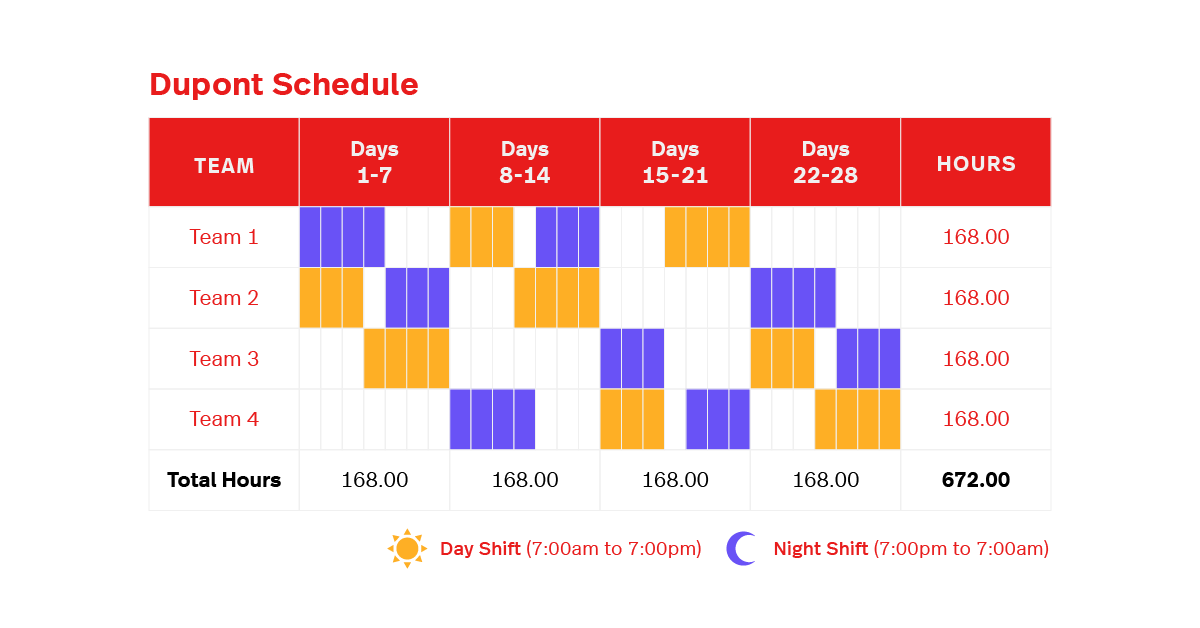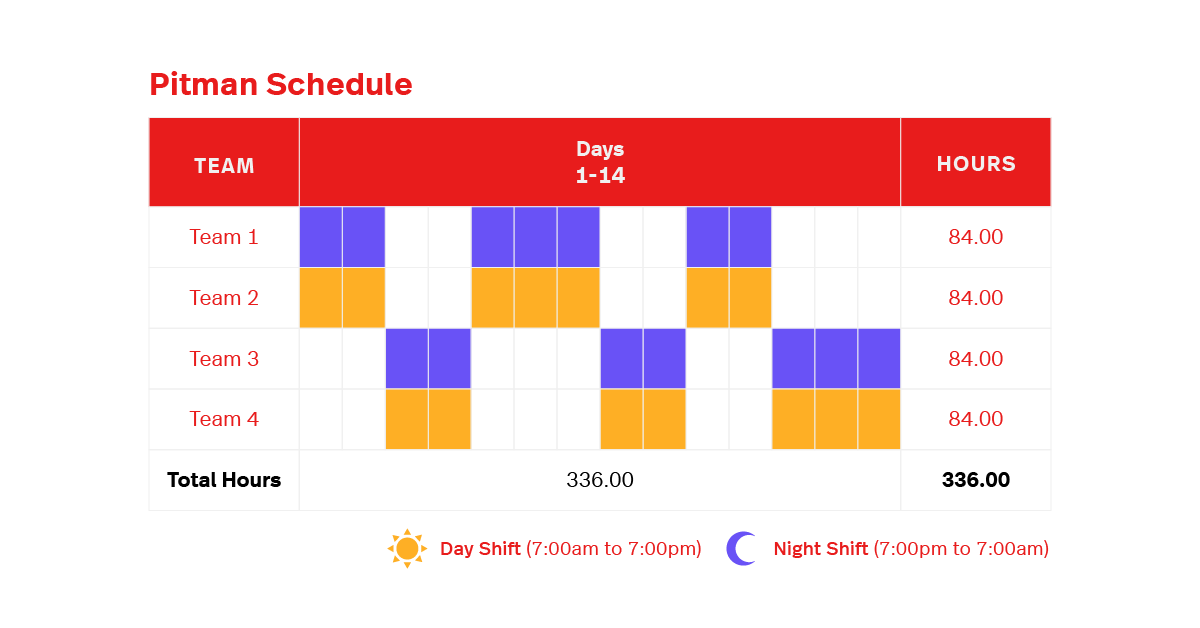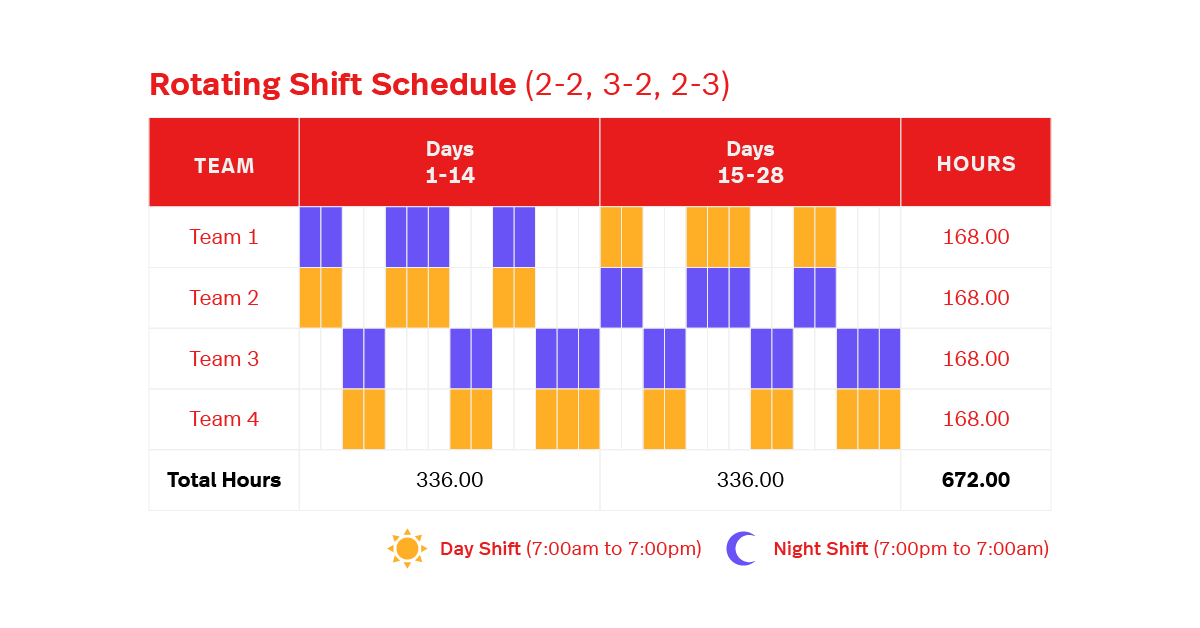
From rotating work schedules to fixed schedules, there are many types of business, many types of jobs and many types of shift management strategies to cater to them all, because the 40-hour, 9-to-5 lifestyle just doesn’t always cut it.
Business owners and managers who operate establishments that are open outside of the regular work hours (such as restaurants, bars, convenience stores and hospitals) must find a way to keep their bases covered and their employees happy. But what is the best strategy to successfully check both boxes?
In this blog, we’ll cover:
- What a rotating schedule is
- How rotating schedules work
- Fixed vs. rotating schedules
- 3 types of rotating work schedules
- How to make a rotating work schedule
Simplify your employee scheduling
With Lightspeed and Homebase’s two-way integration, you can plan your employee schedule with ease.
What is a rotating schedule?
A rotating schedule is just like it sounds: employees are scheduled for a certain shift, such as the night shift, and then rotate with the other teams working the day shift for the next set period of scheduling. Some instances call for a third shift rotation, but after that the scheduling cycle begins again.
How does a rotating schedule work?
Let’s take a look at two examples to better understand the logistics of a rotating schedule.
You work at Sally’s Diner, and employees need to be there from 8 a.m. to 12 a.m.
The manager will most likely break down the work hours into two eight-hour shifts, with one shift running from 8 a.m. to 4 p.m., and the next shift starting at 4 p.m. and ending at 12 a.m.
If the manager operates under a fixed schedule, you would be on a designated team of shift workers for either the day shift or night shift, and you’d be scheduled the same hours each cycle.
This may make sense for office-work or labor jobs that would be the same no matter the shift, but at Sally’s, the night shift is much more lucrative tip-wise than the day shift, so it’s not fair that the same staff members have to work the day shift every week.
So, your manager makes it fair by choosing the rotating schedule route. This means you work the day shift for a couple of weeks, and then you switch to the night shift and so on and so forth. Depending on your restaurant’s tip out structure, everyone gets a fair shot at making good tips.
Or, perhaps, you work at Freddy’s General Store, open from 9 a.m. to 9 p.m. every day. On a fixed schedule system, you might have 8-hour shifts for full-timers and 4- to 6-hour shifts for part-timers to ensure total coverage.
But your manager wants to make scheduling a little easier for them to plan and employees to predict. They propose a new rotating work schedule—you’ll be working 12 hour days, but you’ll always know what days in a month you’ll be working, and you might even be making a little more due to the longer hours.
Different types of work schedules: Fixed vs. rotating schedules
A rotating schedule might not work for you, and that’s okay—you can instead operate on a fixed schedule.
What is a fixed schedule?
A fixed schedule consists of one set team of employees that works the day shift, another set team that works the night shift, and a third team that works whatever swing shift the business might need. The employees are not placed on a cycle and the schedule does not change.
The benefits of a fixed schedule
Many employees (though typically not restaurant staff members) say they prefer a fixed schedule due to the predictability of their shifts. The consistency of the schedule makes it easier for them to stick to a routine, and they can easily hold second jobs or go to college. A fixed schedule allows employees to sleep around the same time every day, making it easier for them to maintain a healthy sleep pattern.
The benefits of a rotating schedule
As mentioned before, a rotating schedule largely benefits restaurant staff members who may not receive as many tips if they are stuck on the same slow shift every week. Still, there are many more reasons a rotating scheduling plan works.
Crucial experience
If you have employees that only work the slower traffic shift, they may have a hard time if they end up having to work during peak hours. With occasional shift swaps, it’s likely that these employees will eventually need to cover a busy shift.
Instead of a shift-shock to the system, a rotating schedule will give all employees a chance to understand the ebb and flow of your business. When employees both have training and have experience working all shifts, you’ll know you can count on them around the clock.
Flexibility
When an employee needs time off, you’ll need to find someone else to fill in. Having employees that are comfortable working each shift means that you will have a ready and willing group to take their spot. Having flexibility in your schedule means that employees can make room for other things they need to do in their lives.
For example, if you have a set schedule, an employee might need to take the day off to make it to an appointment or family event. Instead, if you have a rotating schedule with more flexibility, they may be able to schedule around their shifts and not have to miss work after all. It’s a win for employees and a win for business owners as well.
Fixed vs. rotating schedule: which should retailers use?
Some rotating schedule methods are simply designed for businesses that stay open much longer than your average retail store. If you’re only open 10 hours a day, a fixed schedule might work better. If you’re running a convenience, grocery or discount department store, you might be open 24/7—and that means rotating shifts might work better for you.
Fixed schedules tend to lead to less hours worked. The shifts are shorter, and rotating work schedules often correlate with more overtime than fixed schedules. While this does mean more pay for your workers, it also means more hours worked. Whether the benefit outweighs the downside is subjective.
If you’ve been dealing with high churn (the bane of every retailer) you might be able to cut down on employee burnout by using a rotating work schedule. Having more days off in a row—as is common with rotating shifts—gives employees a chance to better manage their personal lives so they show up to work well-rested.
Fixed schedules mean some employees will always be working your busiest days and times, while others will get more calm shifts. Rotating schedules gives everyone an equal opportunity to work the busier days. Whether fixed or rotating schedules are best for your business to address busy shifts is up to your teams—some may thrive on the busy shift, while others prefer the quiet shift. Or everyone might prefer a mix.
3 types of rotating work schedules
While managers can certainly keep the rotation simple, there are many other ways to break shifts down into rotating schedules, and each one is tailored to different operating styles. Here’s a look at your three options.
- Dupont shift schedule
- Pitman shift schedule
- 2-2, 3-2, 2-3 shift schedule
Dupont shift schedule: 24/7 coverage
The Dupont method is a popular scheduling strategy for businesses that need 24/7 coverage. It features 12-hour rotating shifts and breaks employees into four teams who rotate through an eight-part cycle that goes as follows:
- Four night shifts
- Three days off
- Three day shifts
- One day off
- Three night shifts
- Three days off
- Four day shifts
- Seven days off

Pros of the Dupont rotating work schedule
This method benefits employees because they have a built-in, week-long vacation every month. If you’re a 24/7 retailer, your managers might be struggling to find enough people to work the night shift. With that week-long vacation and with no one working the night shift permanently, hiring could potentially be easier.
Cons of the Dupont schedule
While a week-long vacation is nice, every four weeks employees have to work 72 hours in one week and only get one 24-hour break in the middle. They also might have trouble readjusting to work-life after having seven consecutive days off duty.
Pitman shift schedule: rotating weekend schedule
The “every other weekend off” plan also consists of four teams working 12-hour shifts. The teams operate on a two-week cycle that looks like this:
- Team 1: Two day shifts, two days off, three day shifts, two days off, two day shifts, three days off
- Team 2: Two night shifts, two days off, three night shifts, two days off, two night shifts, three days off
- Team 3: Two days off, two day shifts, three days off, two night shifts, two days off, three night shifts
- Team 4: Two days off, two night shifts, three days off, two day shifts, two days off, three day shifts

Employees will work around 42 hours a week on the Pitman Schedule.
Pros of a rotating weekend schedule with Pitman
Obviously, with this method, employees will have every other weekend off. They will also never work more than three days in a row. Because they’re likely showing up to work before rush hour (and leaving after it), a Pitman schedule may offer your employees a less stressful commute.
Cons of the Pitman shift schedule
Employees will have to work 12-hour shifts, which can be grueling. Even with the lure of weekends off and less days worked in a row, long shifts may make hiring difficult.
2-2, 3-2, 2-3 rotating shift schedule: alternating shifts
This plan is an alternate version of the Pitman shift schedule and also uses four teams, two 12-hour shifts and a four-week cycle. Employees work day or night shifts exclusively for two weeks and then switch the opposite shift for the next two weeks. The shift schedule goes as follows:
- Two day shifts
- Two days off
- Three day shifts
- Two days off
- Two day shifts
- Three days off
- Two night shifts
- Two days off
- Three night shifts
- Two days off
- Two night shifts
- Three days off

Pros of rotating work schedules with 2-2, 3-2, 2-3
Much like the other version of the Pitman schedule, employees will enjoy three days off every other weekend and will never work more than three days in a row. This offers employees a lot of time to take care of their families and schedule appointments without needing to take time off.
Cons of rotating work schedules this way
As a downside, this schedule requires employees to work up to 62 hours in one week, and the switch from day to night shifts can cause disruption in their sleep patterns.
How to make a rotating work schedule
The easiest route for your business would most likely be the first one we mentioned: two teams switching between the day or night shift every two weeks. However, it doesn’t take into account how many days a week your employees work, nor does it include a weekend strategy, so it would be best to configure a scheduling strategy using one of the other plans.
To teach you how to do so, let’s take a step-by-step walkthrough of scheduling using the Pitman method.
- Divide your employees into teams
- Assign each team to a shift
1. Divide your employees into teams
Each team should consist of employees who can fulfill every duty you need per shift: waitstaff, food runners, cooks, and bartenders. Label the teams so you can keep up with who’s who. For example, we’ll label them 1, 2, 3, and 4.
2. Assign each team to a shift
The Pitman method operates on a two-week rotation, so each team will work their designated shift for two weeks before moving to the next plan.
We showed you how the Pitman schedule works already, but here’s how you’ll set up the team rotations:
Team 1
- Week one: Two day shifts, two days off, three day shifts
- Week two: Two days off, two day shifts, three days off
- Week three: Two night shifts, two days off, two night shifts
- Week 4: Two days off, two night shifts, three days off
Team 2
- Week one: Two days off, two day shifts, three days off
- Week two: Two night shifts, two days off, two night shifts
- Week three: Two days off, two night shifts, three days off
- Week four: Two day shifts, two days off, three day shifts
Team 3
- Week one: Two night shifts, two days off, two night shifts
- Week two: Two days off, two night shifts, three days off
- Week three: Two day shifts, two days off, three day shifts
- Week four: Two days off, two day shifts, three days off
Team 4
- Week one: Two days off, two night shifts, three days off
- Week two: Two day shifts, two days off, three day shifts
- Week three: Two days off, two day shifts, three days off
- Week four: Two night shifts, two days off, two night shifts
Each team has the same pattern of rotation, they’re just staggered so that every shift is covered. To make things easier, you can use an employee scheduling software such as the free Scheduling App from Homebase to easily copy last week’s shift schedule and switch the names around so you only have to set up the rotation once.
Which schedule type works best for your business?
The most important aspect of choosing which type of scheduling strategy is best for your business is to communicate with your staff members and figure out which type is best for them.
Whether your employees are motivated by the flexibility and fairness of the rotating schedule, or prefer the consistency of the fixed schedule, your business will run the smoothest if your team is happy.
To keep your team happy while they’re on shift, make sure they’re using an intuitive POS system like Lightspeed that makes their job easier. Watch a demo to see what we’re all about.

News you care about. Tips you can use.
Everything your business needs to grow, delivered straight to your inbox.



